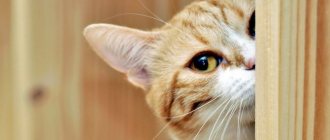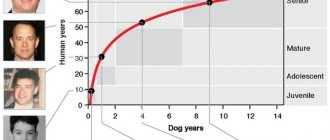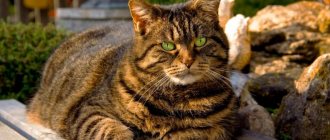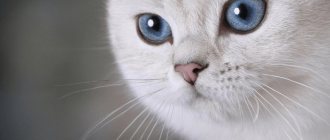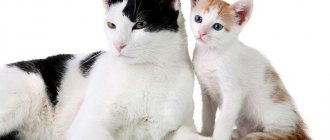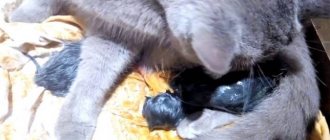Home » Useful Information
Many owners are interested in the question: how old is a cat by human standards?
As your pet ages, its behavior changes greatly.
From a small playful kitten, he turns into a calm cat, spending more time sleeping and less time on outdoor games.
Time passes faster for cats than for people.
To determine the age of your pet, you can refer to the correspondence table.
- 2 Option two - age ratio
- 3 Option three – elementary arithmetic
- 4 What to do if the pet’s age is unknown
- 5 Does breed affect life expectancy?
- 6 Does an animal’s lifestyle matter?
- 7 What the owner can do
The first option is calculation with a coefficient
To find out how old a cat is by human standards, a coefficient is often used.
This number determines the number of human years a cat lives in one year.
Each age group has its own characteristics
The calculations are based on social and emotional characteristics.
After all, comparing the logic of a person and a cat is not entirely correct.
The following is a table for this type of calculation.
Of course, this table contains only approximate data.
If the exact age of the cat is not known, a veterinarian will help determine it approximately.
At the same time, he will assess the health of the pet’s teeth and the condition of the body as a whole.
Important! It is extremely difficult to obtain reliable data on the level of intelligence in cats, therefore all methods of converting from age to human age are only approximate.
Although the coefficient gives a general idea of how old a cat is by human standards, it cannot be said that this is accurate data.
You should not think that at two years old the cat is fully formed intellectually and has adapted socially.
Such a table rather shows the aging of the body, its wear and tear.
Older cats are calm and measured
Why 1:7
Each of these theories interprets a cat's age differently. It can be seen that at the beginning of each table there is approximately the same ratio - 1:7. Why is this so? Note that comparison of the age of a cat and a person is conditional and not scientific. Experts draw an analogy between the main age stages (childhood/old age). A person’s characteristics of physical and emotional development are taken into account, and periods of social adaptation (infancy, childhood, adulthood) are assessed.
Cats have all this too. They have similarities with humans in every period. The stages of growing up have the same sequence, but different paces. For example, childhood ends much faster for cats than for humans. If we compare the childhood period of a cat and a human, it turns out that in an animal it is on average 7 times shorter. The remaining stages of life also have temporary differences with us.
Option two - age ratio
There is another way to convert a cat's age to human age.
Moreover, each year is equivalent to several years of people’s lives.
- The first year of life is counted as 15 human years.
- Second year - by 24.
- Each subsequent year adds 4 years to the age, this figure remains unchanged until the age of 16.
- After 16 years, each year lived is equal to 3.
With this calculation system, a two-year-old cat is perceived as a 24-year-old girl, and when she reaches 12 years old, as a 64-year-old lady.
Using this recalculation option, a number of analogies can be drawn.
For example, up to 1 year (like a person up to 15 years old), a cat learns to take care of itself, get along with its owner, and so on.
At the same time, the animal goes through puberty.
At two years old, the cat already has a formed character and knows how to demand from the owner what she needs (or simply wants).
Her behavior at this stage is really reminiscent of a young man or girl at the age of 24.
If we continue this calculation, by the age of 15 (which is 76 years in human terms), a cat, like an elderly person, may develop diseases.
And her behavior can change according to her age.
Age-specific features include the following:
- decreased interest in games;
- the appearance of behavioral characteristics characteristic of adults.
Breed affects age characteristics
Important! The appearance and nature of age-related changes depend on the breed of cat.
Periods of human development
First comes the period of infancy. The newborn is completely dependent on the parents, cannot walk, talk, and does not eat adult food. Then comes childhood. The child grows, gains weight, learns to read and write, explores the world, goes to school, makes friends. Boys and girls choose a profession, go to college, and socialize in society. During this period, interests and life attitudes are formed, puberty occurs. An adult works and starts a family. In old age, health-related issues often arise, visual acuity and senses become dull, and activity decreases.
Option three - basic arithmetic
The simplest way to calculate how old a cat is by human standards is to multiply its age by 7.
In this case, each year of a furry pet’s life will be equivalent to 7 years of human life.
The result is not the most accurate.
A cat that has reached the age of one is much more independent than a 7-year-old child. After all, she is driven by instincts.
However, many more animals live to be 20 years old than people live to be 140.
These kittens are still very small
The main disadvantage of this method is that it does not allow one to compare the stages of development in humans and animals.
Therefore, this method is less preferable in calculations.
Long-lived cats
Cream Puff with his owner
- The oldest cat named Cream Puff was included in the Guinness Book of Records because she lived for 38 years. This is the only officially confirmed case of longevity of a pet. The cat lived in America in the town of Austin, Texas, where she was born. The owner was Jake Perry, who pampered his pet with eggs, bacon, broccoli and asparagus. Cream Puff enjoyed enormous popularity, and even became the heroine of a detective novel by Barbara Brady.
- In 2022, another long-lived cat, a cat named Rubble, died. It was presented as a gift for Michelle Heritage's 20th birthday. The pet lived in Exeter, a city in Devonshire. The woman had no children, so the cat received all the attention and care. In May 2020, Rubble would have turned 32 years old, but the record has not been officially recorded. Michelle did not want to disturb the cat and expose him to stress, so she refused the tedious ceremonies.
- Russia also has its own long-lived cats. One of them is named Basilio from Kostroma, who appeared in the family of Elena Kolotova in the difficult 90s. The woman was caring for a weak kitten, because he could not eat on his own. Elena’s two dogs, with whom Basilio became friends, became nannies for the little bundle. The cat died in 2016 at the age of 26, which is considered a major achievement.
What to do if the pet's age is unknown
If a cat was picked up on the street, it will be difficult to determine how old it is at the moment.
However, age is important to know in order to find out how old a cat is by human standards.
Determining age can be entrusted to a veterinarian
To determine a cat's age, its teeth are examined.
Of course, it is better to have this done by a veterinarian.
Your furry friend is unlikely to enjoy oral examination.
If it is not possible to go to the doctor with this question, you should first study the progress of dental development.
- When a kitten is 1 month old, its baby teeth appear.
- At the age of 5-6 months they are replaced by permanent ones.
- Upon reaching 1.5 years of age, the central incisors of the lower jaw are worn away.
- Upon reaching 2.5 years of age, the middle incisors of the lower jaw wear off.
- At three and a half years of age, wear of the central incisors of the upper jaw occurs.
- At four and a half years of age, wear of the middle incisors of the upper jaw occurs.
- At the age of five, the fangs wear off.
- By the age of six, the outer incisors of the upper jaw begin to wear off.
- At the age of 7-8 years, modifications are observed in the rubbing surfaces of the central and middle incisors of the lower jaw.
- By the age of 9, wear of the central incisors of the upper jaw begins.
- At 10-12 years old, the central incisors may fall out.
- By the age of 15, all incisors may fall out.
Of course, these numbers vary depending on the animal’s lifestyle. diet plays a significant role .
If your cat's diet contains enough vitamins and minerals, the process of tooth wear and loss will noticeably slow down.
The condition of the teeth says a lot about the age of the cat.
By external signs
The approximate age of cats can be determined by the type of animal. It's easy to understand where the kitten is. If the animal is an adult, this is more difficult to do.
The condition of the coat indicates age. If it is healthy and shiny, then most likely the cat is no more than 6 years old. An assessment of behavior and emotional development will provide more information. The most active are teenagers aged 1-2 years. Adults are more passive.
Does breed affect life expectancy?
Actually the answer to this question is yes. They can live much longer:
- mongrel cats;
- animals of natural or long-bred breeds.
Exotic cat breeds bred by humans live much shorter lives.
The reason lies in the fact that in order to preserve the characteristics of the breed (in the British , Maine Coons , Munchkins, Cornish Rex, exotics ), a small number of individuals are involved in breeding.
Cats that are not bred through selective breeding have much better developed immune systems and survival abilities.
Older cats need to rest more often
Who lives longer: cats or cats?
When comparing representatives of different sexes, it is impossible to say for sure whose life will be longer. Unneutered cats engage in fierce fights for territory, and wounds do not add health. Cats' bodies are worn out by childbirth and feeding their offspring, which shortens their life expectancy. Cats are more likely to suffer from urolithiasis due to their narrow urethra. The vulnerable spots of cats are the mammary glands and internal genital organs, where tumors develop.
Does an animal's lifestyle matter?
For cats to live happily ever after, they need to be given the most favorable conditions possible. These include:
- proper, balanced nutrition;
- cozy, warm house ;
- no injuries;
- periodic visits to the veterinarian;
- protection from external adverse factors.
If you are interested in detailed information about proper grooming, we recommend that you read the article
In addition, the following factors affect life expectancy in cats:
- heredity;
- presence/absence of genetic diseases.
It is worth noting that sterilized cats and castrated cats have a longer life expectancy than individuals participating in procreation.
We recommend an article on the importance of sterilizing cats
The absence of stress during the mating season has a positive effect on their condition.
Neutered cats live longer
Interesting! According to the observations of veterinarians, the life expectancy in most cases in cats is from 10 to 15 years.
